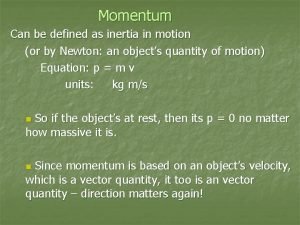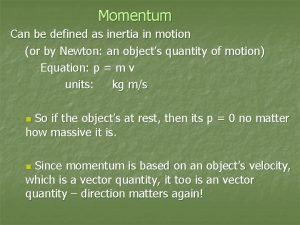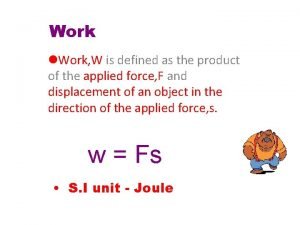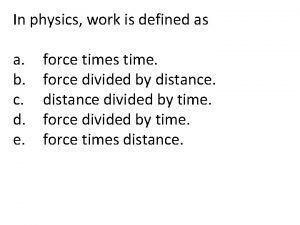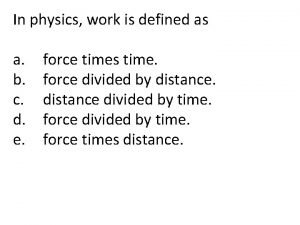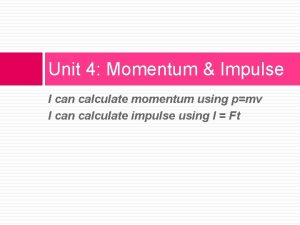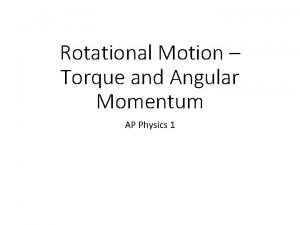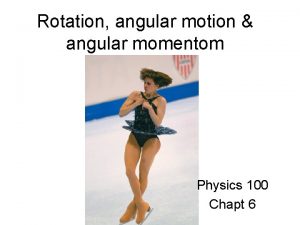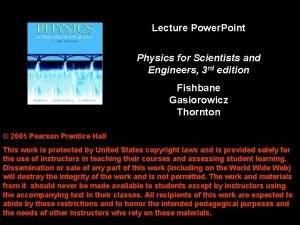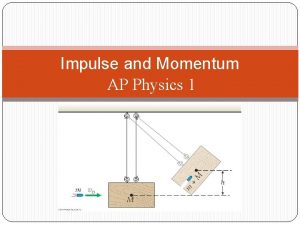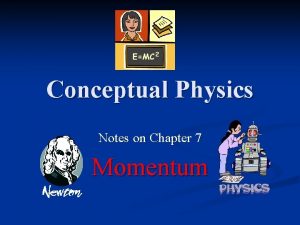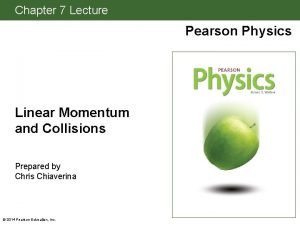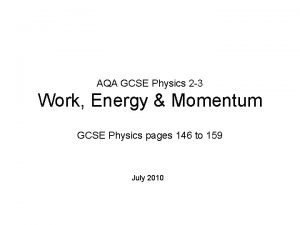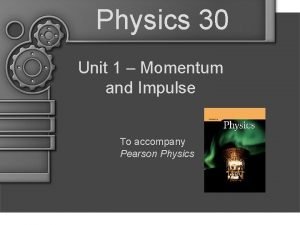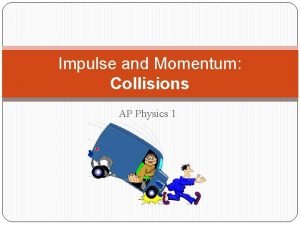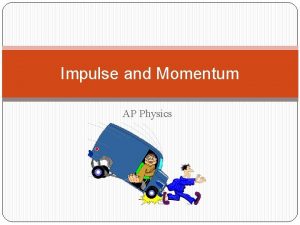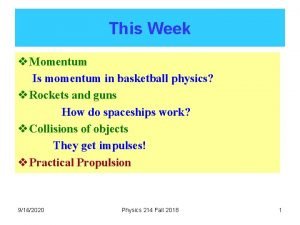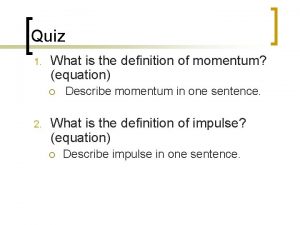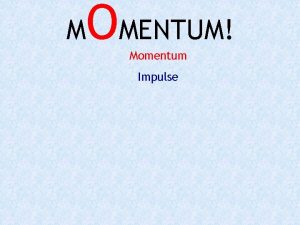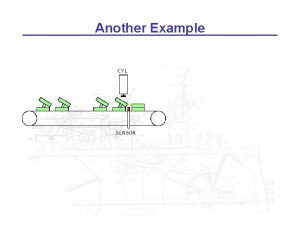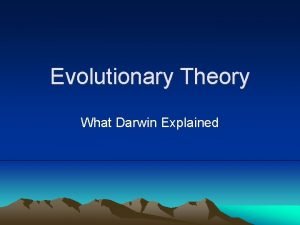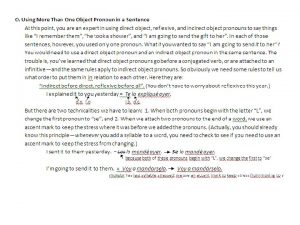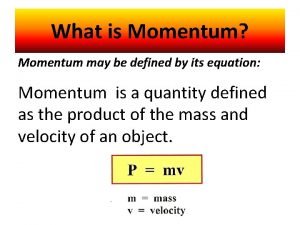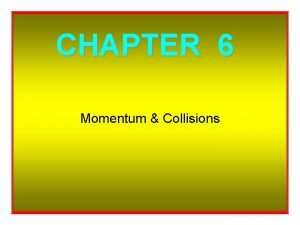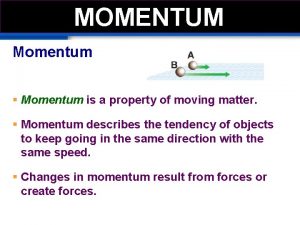Momentum Yet another physics mystery explained Momentum defined































- Slides: 31

Momentum Yet another physics mystery explained

Momentum defined • • • Momentum = mass X velocity Symbol for momentum = “p” Symbol for mass= “m” Symbol for velocity= “v” So p = mv

Let’s think about momentum • Momentum is made up of 2 quantities: mass and velocity. • They multiply together to give the momentum. • Let’s see if we can rank some situations in order of increasing momenta (“momenta” is the plural of “momentum”).

Ranking Momenta A fast flying bee The earth in orbit around the sun A parked garbage truck A slowly flying bee Your grandmother driving down the street in her 1959 Edsel • An oil tanker sailing the seven seas. • Tony Hawk grinding on a rail • • •

Impulse • If the momentum of an object changes, that means that at least one of these quantities changes – Its mass – Its velocity • Usually, mass doesn’t change, so it’s most of the time it is the velocity that does • Recall that Δv/Δt = acceleration

Impulse • What provides this acceleration? – FORCE • Let’s say you provide a certain force for a short period of time. You will produce a certain change in momentum. • What if you provide that same force for longer? You should produce a greater change in momentum.

Impulse • Example we all know and love: Gravity • If we let something free fall under gravity (no air resistance) for 3 sec, it’s change in momentum is less than if we let it free fall for 6 seconds.

Impulse defined • We define “impulse” as: Force X the length of time it is applied. • Impulse = Ft • Impulse is also equal to the change in momentum, so: Ft = mv

So what does this mean? • Let’s think about 2 situations: • Situation 1: pushing someone in a rolling chair – If you push on them with a certain force for two different times, the longer time will result in a greater change in momentum – So if the chair was at rest to begin with, it will end up going faster at the end for the longer time the force was applied

So what does this mean? • Situation 2: crashing your 1, 000 kg car • Let’s say you are driving along at 45 m/s (about 96 mph) and you crash into one of two objects: a solid wall or a series of water-filled plastic bins (like they have on the highway) • If your car goes from 45 m/s to 0 m/s, you have a change in momentum of: • P = mv, so momentum = (1000 kg)(45 m/s) = 45, 000 kg • m/s

Which would you rather? • Recall that impulse = change in momentum, so Ft = mv = 45, 000 kg • m/s • So, Force X time = 45, 000 kg • m/s • Now, would you rather have that force spread out over a long time, or over a short time?

Compare stopping times • Change in momentum is 45, 000 kg • m/s • For a stopping time of 5 sec (slamming on your brakes): (F)(5 sec) = 45, 000 kg • m/s – So F = 9, 000 N • For a stopping time of 1. 5 sec (smashing into the plastic water bins): (F)(1. 5 sec) = 45, 000 kg • m/s – So F = 30, 000 N • For a stopping time of 0. 2 sec (smashing into the concrete wall): (F)(0. 2 sec) = 45, 000 kg • m/s – So F = 225, 000 N

Let’s look at those numbers more closely… • Remember we have a 1, 000 kg car and F = ma • If F = 9000 N, then accel = 9 m/s (just under acceleration due to gravity) • If F = 30, 000 N, then accel = 30 m/s (just over 3 X acceleration due to gravity) • If F = 225, 000 N, then accel = 225 m/s (about 23 X the acceleration due to gravity) • So, which is the most survivable?

Bungee Jumping


Bouncing • Show of hands: When an object bounces upon landing, is the impulse greater or smaller than when it just sticks? • Support your answer.

Bouncing: the actual answer • A greater impulse is needed to make an object bounce than to land stick. • Let’s do math: – If a 5 kg object goes from 5 m/s to zero m/s, its impulse is (5 kg)(0 m/s – 5 m/s) = -25 kg m/s – If a 5 kg object bounces up at 5 m/s instead of staying at zero, then impulse is (5 kg)(-5 m/s – 5 m/s) = -50 kg m/s – In other words, going from V to –V makes the impulse twice as large as going from V to zero

Conservation of momentum • In general, momentum is conserved • This means that the momentum at the beginning is the same as the momentum at the end • I. e. momentum is not created or destroyed • Remember, symbol for momentum is ‘p’ • So PI = ‘initial momentum’ and PF = ‘final momentum’ • Let’s look at some examples

Conservation of Momentum: Example 1 • Cannon and cannonball • What is momentum before cannon is fired (PI)? • Zero • So what does final momentum (PF) have to be if momentum is conserved? • Zero http: //www. sparknotes. com/testprep/books/sat 2/physics/chapter 9 section 3. rhtml

Conservation of Momentum: Example 1 • Let’s say that the cannon has a mass of 1000 kg and Cannonball has a mass of 10 kg • So total PI = PI of ball + PI of cannon • PI of ball = (10 kg)(0 m/s) = 0 kg m/s • PI of cannon = (1000 kg)(0 m/s) = 0 kg m/s

Conservation of Momentum: Example 1 • Now let’s say that the cannonball moves to the right at 75 m/s. How fast does the cannon move to the left to conserve momentum? • PI = P F • So PF must equal zero

Conservation of Momentum: Example 1 • PF must equal zero • Total PF = PF of ball + PF of cannon • Remember, moving to the right = positive velocity • Moving to the left = negative velocity

Conservation of Momentum: Example 1 • PF = 0, so • (10 kg)(75 m/s) + (1000 kg)(Vcannon) = 0 • So -Vcannon = (10 kg)(75 m/s) / (1000 kg) • Vcannon = -0. 75 m/s • If ball moves to the right, cannon moves to the left, so Vcannon should be negative, which it is

Conservation of Momentum: Example 2 • Newton’s cradle (or “Executive ball clicker” or, more crassly, “Newton’s Balls”) • How does it work? • If one ball is used, how many come up on the other side? • If two are used…?

Collisions (now the REALLY fun part) • In the absence of external forces, a collision obeys the law of conservation of momentum • I. E. , the total momentum AFTER the collision is the same as the total momentum BEFORE the collision • There are two kinds of collisions: – Elastic – Inelastic

Collisions Continued (how alliterative…) • Elastic Collision: a collision in which no energy is lost – In the real world, how is energy lost in a collision? – Sound is generated – Heat is generated – Objects are deformed • In a perfectly elastic collision, we pretend that these things don’t happen. In the real world this is almost never true, but we can make approximations and pretend.

More collisions • Inelastic collision: a collision in which energy is NOT conserved (so there is sound/heat/deformation/screaming) • Even in an inelastic collision, MOMENTUM IS STILL CONSERVED • Completely inelastic collision: a collision in which the two objects stick together – Examples: – Train cars coupling – Throwing a lump of clay at a student and having it stick to their head

Sample problem 1 for some lucky student to solve • Pool ball A (mass 0. 1 kg) is moving to the right at 2 m/s and hits pool ball B (same mass), which is initially at rest. If pool ball B moves on to the right at 2 m/s, what is the final velocity of pool ball A? • Set up the problem: PIA + PIB = PFA + PFB • (0. 1 kg)(2 m/s) + 0 = (0. 1 kg)(VFA) + (0. 1 kg)(2 m/s) • 0. 2 kg m/s = 0. 2 kg m/s + (0. 1 kg)(VFA) • So VFA = 0 m/s

Sample problem 2 for some lucky student to solve • A lump of red clay (1 kg) is moving at 3 m/s to the right and strikes (and sticks to) a lump of blue clay (1 kg) moving 3 m/s to the left. What is the final velocity of the system? • Total PI = Total PF • (1 kg)(3 m/s) + (1 kg)(-3 m/s) = (1 kg + 1 kg)(VF) • 3 kg m/s – 3 kg m/s = 0 kg m/s • So 0 kg m/s = (2 kg)(VF), so VF = 0 m/s

Sample problem 3 for some lucky student to solve • A railroad car full of Lady Gaga CD’s (mass 10, 000 kg) is moving at 5 m/s and then collides and couples with a railroad car full of Lil’ Wayne CD’s (mass 10, 000 kg), which is initially at rest. What is the final momentum of the system? What is the final velocity of the system? • Total PI = Total PF , so PF = (10, 000 kg)(5 m/s) = 50, 000 kg m/s • (10, 000 kg)(5 m/s) + 0 = (20, 000 kg)(PF) • (50, 000 kg m/s) / (20, 000 kg) = 2. 5 m/s = PF

Sample problem 4 for some lucky student to solve • Car A (mass 1000 kg) slides to the right on frictionless ice at 12 m/s and hits car B (mass 1200 kg), initially at rest. After the collision, car A moves to right at 3 m/s. How fast does car B move? • (1000 kg)(12 m/s) + 0 = (1000 kg)(3 m/s) + (1200 kg)(VFB) • 12, 000 kg m/s = 3000 kg m/s + (1200 kg)(VFB) • 9000 kg m/s = (1200 kg)(VFB) • (9000 kg m/s) / (1200 kg) = 7. 5 m/s
 Lex yacc example
Lex yacc example What is yet another resource negotiator
What is yet another resource negotiator Yet another day
Yet another day Bash framework
Bash framework A collection of well-defined objects
A collection of well-defined objects Is harris burdick a real person
Is harris burdick a real person Momentum can be defined as
Momentum can be defined as Momentum can be defined as
Momentum can be defined as What is work in physics
What is work in physics Work definition physics
Work definition physics In physics, work is defined as *
In physics, work is defined as * If you lift one load up two stories how much work
If you lift one load up two stories how much work In physics, work is defined as
In physics, work is defined as Chapter 6 momentum changing momentum
Chapter 6 momentum changing momentum Physics 03-02 potential energy and conservative forces
Physics 03-02 potential energy and conservative forces Unit for momentum
Unit for momentum Theorem of angular momentum
Theorem of angular momentum Angular vs linear momentum
Angular vs linear momentum Ap physics 1 momentum equations
Ap physics 1 momentum equations Right hand rule for torque
Right hand rule for torque Ap physics momentum
Ap physics momentum What is momentum in physics
What is momentum in physics Conceptual physics chapter 7 momentum answers
Conceptual physics chapter 7 momentum answers Momentum definition in physics
Momentum definition in physics Momentum gcse
Momentum gcse Physics 30 momentum and impulse
Physics 30 momentum and impulse Ap physics 1 momentum and impulse
Ap physics 1 momentum and impulse Impulse law
Impulse law Impulsive force
Impulsive force Basketball impulse and momentum
Basketball impulse and momentum Whats the definition of momentum
Whats the definition of momentum What is momentum
What is momentum






